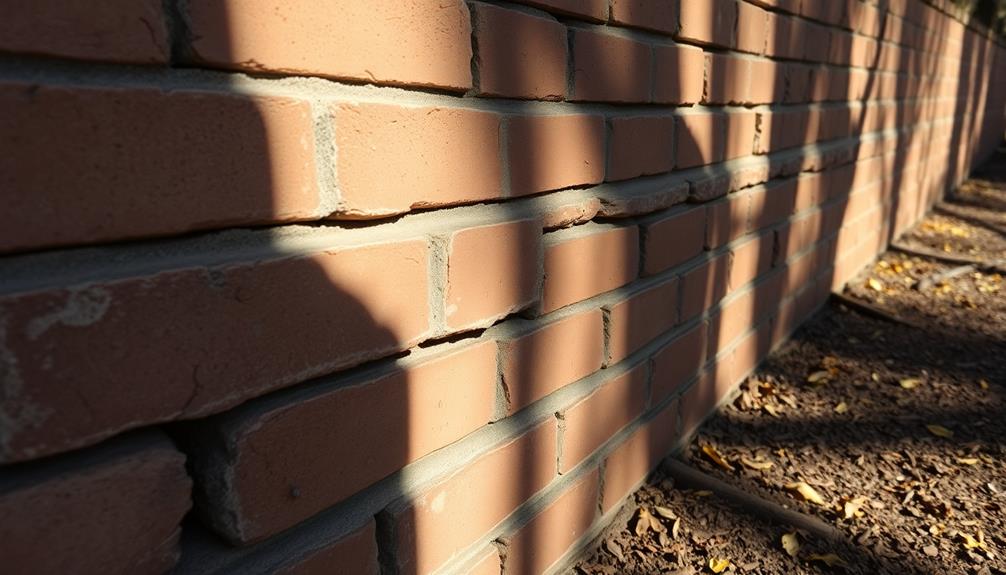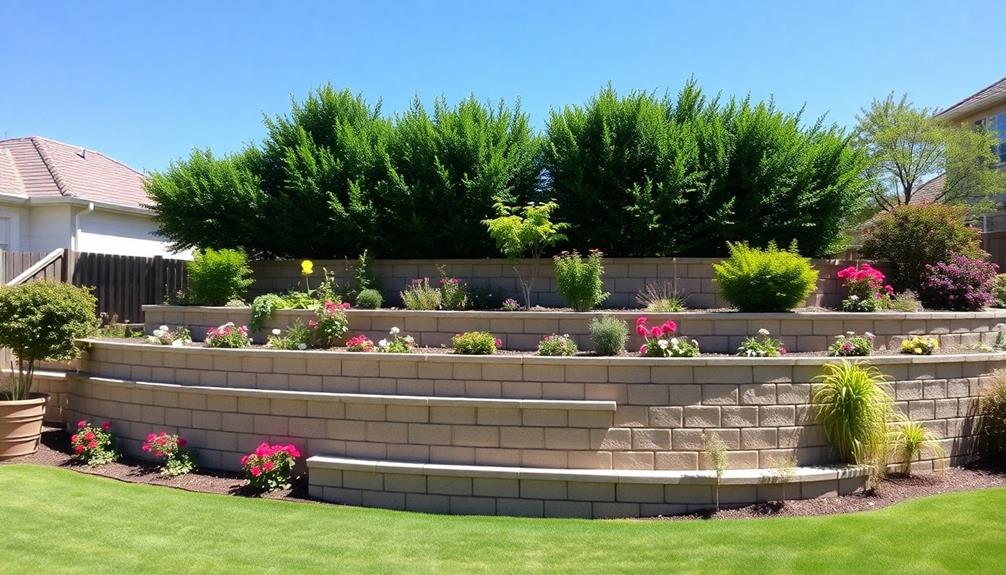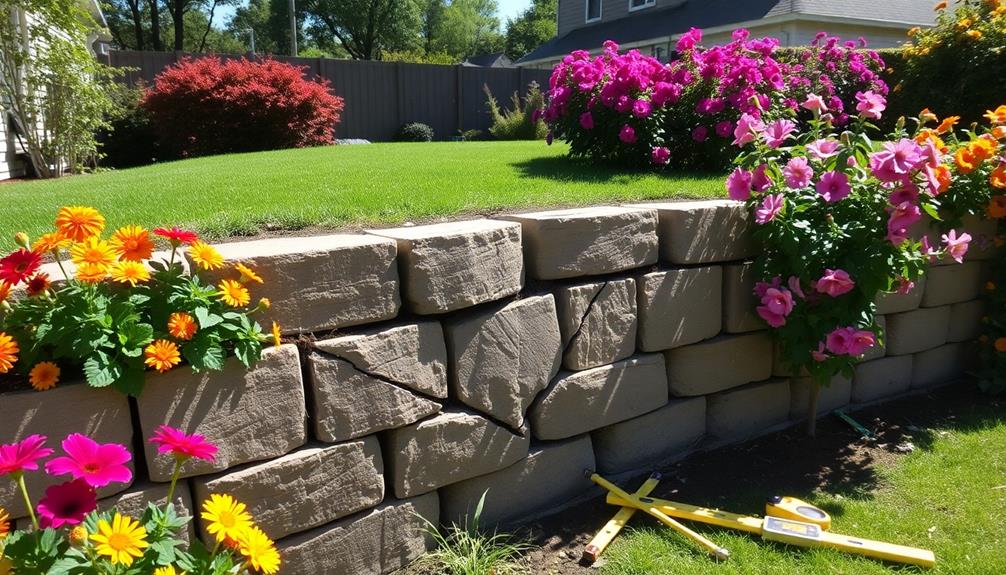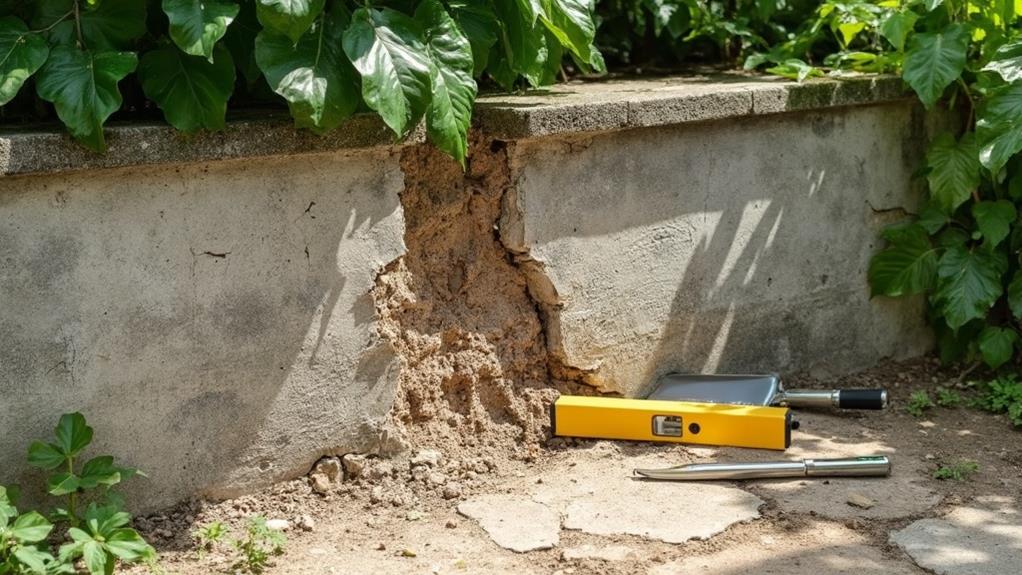When your retaining wall exhibits cracks, immediate action is essential to avert further structural deterioration. Start by examining the crack's dimensions and locations, as well as environmental conditions, which can reveal underlying causes such as hydrostatic pressure or soil movement. For minor fissures, apply high-quality masonry sealant, but deeper or more widespread cracks necessitate consultation with a structural engineer. Prevention strategies include improving drainage systems and ensuring well-compacted backfill. Bolstering wall integrity safeguards both function and aesthetics, making professional inspection indispensable to identifying repairs from crack injection to full wall replacement. Further insights can enhance your understanding of effective solutions.
Table of Contents
ToggleWalls Contractor Highlights
- Measure crack width and length to assess its severity before taking action.
- Consult a structural engineer for major cracks to determine the best repair strategy.
- Ensure proper drainage systems are in place to relieve hydrostatic pressure.
- Use high-quality masonry sealants for repairing minor cracks efficiently.
- Inspect and improve soil compaction to prevent further soil movement behind the wall.
Cracks in Retaining Walls

Cracks in retaining walls can originate from a variety of sources, including soil movement, hydrostatic pressure, and temperature fluctuations, each influencing the wall's structural integrity differently. It's worth noting that boulder retaining walls, known for their long-lasting and cost-effective nature, are often more resilient, but can still encounter issues.
Evaluating the severity of these cracks is paramount, as minor surface imperfections might require simple monitoring, whereas significant fissures could indicate deeper structural issues requiring exhaustive intervention. In addressing these problems, implementing effective repair strategies and preventative measures is essential to extend the lifespan of the structure while maintaining its stability and functionality.
Causes of Wall Cracks
Retaining wall cracks can arise from various factors, each contributing to structural vulnerabilities. One primary cause is poor drainage. When water accumulates behind a retaining wall due to inadequate drainage systems, it exerts hydrostatic pressure, leading to stress and subsequent cracking. This is a common scenario in regions experiencing heavy rainfall or where the soil has a high clay content that absorbs and retains moisture.
Another factor is soil movement. Changes in the soil's moisture levels cause it to expand and contract, exerting lateral forces on the wall. Inadequately compacted or expansive soils can exacerbate this movement, compromising the wall's integrity. Additionally, seismic activity or nearby construction efforts may cause vibrations that lead to structural damage over time.
Material quality and construction practices also play pivotal roles. Utilizing substandard materials, neglecting proper reinforcement, and insufficient attention to design specifications can result in cracks post-installation. Temperature fluctuations are another contributor, as thermal expansion and contraction stress the wall, causing fissures, particularly in areas with pronounced temperature shifts throughout the year.
Understanding these causes fosters a deeper appreciation for the complexities of maintaining structural resilience, emphasizing the need for informed construction decisions and ongoing maintenance to belong within a community of well-protected spaces.
Assessing Damage Severity
Evaluating the severity of cracks in retaining walls is vital for determining the appropriate remedial actions. An informed assessment not only safeguards the structural integrity but also enhances the longevity of the wall. Recognizing the urgency with which such an evaluation should be performed caters to a sense of belonging among communities that value safety and sustainability.
When inspecting damage, one must consider various factors to gauge the potential impact on the structure.
- Crack Width and Length: Measure cracks to determine whether they are superficial or structurally significant.
- Location: Assess whether cracks appear in key areas, such as near corners or load-bearing sections.
- Pattern: Evaluate if they exhibit vertical, horizontal, or step-like formations, which may indicate different underlying issues.
- Material and Construction Type: Take into account the materials used, as different ones react variably to stressors.
- Environmental Conditions: Consider external factors like moisture, temperature fluctuations, or soil movement.
Through careful analysis of these parameters, an owner or professional can decide whether immediate intervention is necessary or if the situation can be monitored for gradual changes. Such understanding fosters confidence and empowerment, reinforcing the collective trust within communities committed to maintaining robust and enduring infrastructures.
Repair and Prevention Tips
Proper maintenance practices and timely interventions are essential for addressing cracks in retaining walls effectively. Regular inspections allow property owners to identify vulnerabilities before they worsen, making early repairs more manageable and cost-effective.
For minor cracks, using a high-quality masonry sealant that expands and contracts with temperature changes is vital. This method provides a flexible barrier against moisture ingress, which can exacerbate structural deficiencies.
In more severe cases, consulting with a structural engineer is advisable to determine appropriate solutions such as underpinning or wall reinforcement. These professionals possess the expertise required to assess the stability and load-bearing capacity of retaining walls, ensuring that corrective measures align with safety standards.
Prevention strategies are equally paramount. Proper drainage systems, designed to divert water away from the wall base, minimize hydrostatic pressure, while ensuring that backfill material is well-compacted guards against undue stress.
In addition, selecting materials suited to the specific environmental conditions of the wall's location can considerably reduce the risk of cracking.
Benefits

Understanding the benefits of addressing retaining wall cracks can greatly impact the overall functionality and appeal of a property. Enhanced aesthetic appeal and improved property value often result from timely maintenance and repairs, while increased structural stability guarantees the safety and longevity of the wall.
Collaborating with skilled professionals safeguards the structural integrity and safety of the retaining wall through effective repair techniques. Additionally, addressing these issues can lead to better drainage solutions, preventing water accumulation and potential damage to the surrounding landscape.
Enhanced Aesthetic Appeal
Integrating well-designed retaining walls into a landscape can profoundly enhance its aesthetic appeal, offering both functional and visual benefits. A thoughtfully crafted retaining wall not only serves its purpose in maintaining structural integrity and efficient land use but also elevates the overall beauty of the surroundings, promoting a sense of harmony and belonging among its inhabitants.
The architectural allure of a well-executed retaining wall lies not just in its form but in the multifaceted elements that it introduces to a landscape.
Diverse Material Selection: Whether through natural stone, textured concrete, or brick, the materials selected can reflect personal taste and complement the existing design.
Thematic Cohesion: Walls can be seamlessly integrated into various design themes, from rustic to modern, serving as a key component of a cohesive landscape vision.
Textural Contrast: They provide a dynamic contrast to plant life and natural elements, contributing depth and balance to outdoor spaces.
Artistic Opportunities: Retaining walls offer a canvas for decoration, including embedded lighting, planters, or water features, adding layers of interest.
Color Variations: The wide range of color choices enhances creativity, enabling homeowners to select hues that resonate with the environment or personal preferences.
These elements combine to transform mere soil retention structures into timeless, engaging landscapes that foster an enduring connection to the space.
Improved Property Value
When well-crafted retaining walls are incorporated into a property, they can substantially increase its market value. This enhancement is particularly significant in areas where topographical challenges are present, demonstrating the strategic use of land and providing a sophisticated appearance to the property. These structures not only contribute to the property's aesthetic allure but also reflect an investment in necessary landscaping improvements.
Prospective buyers are more inclined to invest in properties that showcase thoughtful design and functionality. A well-maintained retaining wall offers tangible benefits that resonate with buyers who value long-term property durability and low-maintenance landscapes. The added worth comes from the reassurance that they are acquiring a home that requires fewer modifications and additions due to its pre-existing enhanced groundwork.
Moreover, a skilled and well-executed installation conveys quality craftsmanship, potentially increasing appraisal values and solidifying an owner's bargaining stance. The financial advantage afforded by a functional and aesthetically pleasing retaining wall is unparalleled, as it distinguishes the property in a competitive market. Engaging experts in installation or repair guarantees that any structural integrity issues, such as cracks, are addressed—preserving the property's value and appeal, thus fostering a sense of security and belonging for current and potential homeowners.
Increased Structural Stability
In many landscapes, a well-constructed retaining wall offers numerous benefits, paramount among them is increased structural stability. This feature is not merely a matter of aesthetic value; it signifies an essential component that supports the landscape's integrity, ensuring both longevity and functionality.
For communities, a robust retaining wall signals a collective commitment to safety, allowing for peaceful coexistence within built environments. The enhancement of structural stability in retaining walls provides the following tangible advantages:
- Prevention of soil erosion, safeguarding both land and adjacent structures.
- Support for significant weight, such as that from vehicles, buildings, or additional landscaping.
- Encouragement of land contouring, facilitating the creation of usable land on challenging topographies.
- Reduction of potential land slippage, particularly on inclined terrains.
- Improvement of general safety, mitigating risks posed by unstable soil dynamics.
These benefits are essential not only in managing current land use but also in planning for future developments, allowing individuals to lay roots in an environment perceived as secure and steadfast. As any crack in a retaining wall is a call for immediate action, it underscores the structure's significance in providing enduring support and maintaining the landscape's beauty and practicality for collective satisfaction.
Better Drainage Solutions
Effective drainage solutions in retaining walls markedly enhance the wall's functionality and longevity. By efficiently redirecting water away from the structure, these solutions mitigate the hydraulic pressure that often leads to cracking. Understanding that water accumulation behind retaining walls is a primary catalyst for structural damage, incorporating superior drainage systems becomes indispensable. Such systems not only serve to alleviate immediate stress but also foster enduring stability, ensuring that the investments made in your walls remain protected over time.
Beyond promoting stability, advanced drainage solutions contribute to the wall's aesthetic integrity, preserving its external appearance by preventing unsightly efflorescence and staining. These systems often incorporate state-of-the-art materials, like geo-synthetic fabrics and perforated pipes, allowing for the seamless drainage of water while maintaining soil integrity. Additionally, strategic grading and the installation of weep holes can further support efficient moisture management.
Adopting these measures conveys an adherence to best practices in structural maintenance, fostering a sense of pride and reassurance among community members. By ensuring that retaining walls are both functional and visually appealing, they contribute to a collective sense of belonging, enhancing the communal landscape and safeguarding the property's overall value.
Seek Professional Inspection Immediately

When retaining wall cracks appear, seeking professional inspection without delay is paramount, as experts can precisely identify underlying causes, assess damage severity, and propose suitable repair options. A professional inspection guarantees that potential threats to structural integrity are thoroughly considered and addressed, thereby safeguarding against further complications or costly repairs. Below is a table summarizing these critical inspection elements:
| Aspect | Description |
|---|---|
| Identify Underlying Causes | Detects root issues such as soil movement or drainage problems. |
| Assess Damage Severity | Evaluates the extent and implications of the damage. |
| Explore Repair Options | Provides tailored solutions for effective remediation. |
| Secure Future Stability | Recommends measures to prevent future occurrences. |
Identify Underlying Causes
Promptly seeking out a professional inspection is crucial when cracks appear in a retaining wall, as it helps identify the underlying causes before they escalate into more severe structural problems. By quickly enlisting expert evaluation, homeowners can embrace a proactive approach, ensuring that solutions are rooted in precision and depth of understanding.
Professional inspectors bring expertise that goes beyond mere observation. They employ diagnostic tools and methodologies to reveal the nuances behind wall distress, fostering a sense of trust through their capability to diagnose and inform. The underlying causes of retaining wall cracks can be varied and complex, necessitating specialized knowledge to unravel the intricacies.
Common culprits include:
- Soil erosion which compromises the foundational integrity.
- Hydraulic pressure buildup from inadequate drainage systems.
- Poor initial construction methods or inferior materials.
- Climate effects, such as freeze-thaw cycles impacting structural cohesion.
- Vegetative growth, where roots exert pressure against the wall.
Each factor contributes unique challenges; hence a professional evaluation is not merely advisable but imperative. It assures accuracy in identifying these causes, lighting the path toward effective remediation. Enveloping the process in community-minded diligence, professionals enhance structural safety and societal peace of mind.
Assess Damage Severity
How does one truly appraise the seriousness of cracks in a retaining wall? To determine the potential hazards and implications of such structural imperfections, enlisting the expertise of a professional structural engineer is imperative. Specialized knowledge required to distinguish between superficial tiles and deep structural fissures guarantees not only the longevity of your retaining wall but also the safety of the surrounding environments and communities who rely on its integrity.
A professional inspection involves systematic evaluation, beginning with an extensive visual assessment to ascertain the scope and subtle variations of the damage. Engineers often employ advanced diagnostic tools to gain insights that are not immediately apparent to the untrained eye. The integration of technology such as ground-penetrating radar or thermographic cameras affords an analysis of the wall's substructure, detecting anomalies or weaknesses in materials that might otherwise go unnoticed.
In joining forces with a competent professional, individuals and communities receive informed guidance. As guardians of shared spaces, one gains not only the peace of mind that accompanies a thorough understanding of the current condition but also fosters a sense of protection and unity by proactively safeguarding structural soundness for the collective welfare.
Explore Repair Options
Understanding the extent of damage is only the first step; addressing it promptly to maintain the integrity of the structure is of paramount importance. When a retaining wall exhibits signs of distress, engaging a professional inspection is essential to discerning the severity and potential underlying causes. Such experts bring specialized knowledge and tools to diagnose issues accurately, thereby ensuring effective and long-lasting repair solutions.
Consider the following repair options to restore stability and safety:
- Crack Injection: Utilize epoxy or polyurethane to fill cracks and prevent further water intrusion, ideal for minor, non-structural cracks.
- Wall Anchoring: Strengthen the wall using anchors that provide additional lateral support, especially useful for walls experiencing pressure from retained soil.
- Drainage Improvement: Improve or install drainage systems to mitigate water pressure behind the wall, a common culprit in crack development.
- Partial Reconstruction: Rebuild only the affected section for cost-effective solutions, maintaining wall integrity without full replacement.
- Full Wall Replacement: Consider complete replacement for severely damaged walls where other solutions may not suffice in maintaining long-term stability.
Through professional repair, retaining walls not only regain their structural integrity but also continue to serve as functional and aesthetic components of your landscape.
Walls Contractor FAQ
How Do I Determine the Cause of Cracks in My Retaining Wall?
To ascertain the cause of cracks, thoroughly examine the construction material, drainage systems, and soil pressure. Enlist professional assistance for precise evaluation. This collaborative approach guarantees insights into structural integrity, fostering confidence and community in home maintenance.
What Are the Common Materials Used to Repair Retaining Wall Cracks?
Common materials for repairing cracks in retaining walls include epoxy injections, hydraulic cement, and polyurethane foam. Selecting the suitable material guarantees effective repair, promoting structural integrity. Consultation with professionals enhances the decision-making process, fostering community collaboration and trust.
Can I Continue Using My Garden While the Retaining Wall Is Being Repaired?
Yes, you may continue to use your garden while the retaining wall is being repaired, provided that safety measures are in place. Guarantee repair professionals cordon off the affected area to maintain a secure and uninterrupted garden experience.
Are There Any Temporary Fixes for Small Cracks in Retaining Walls?
Addressing the presence of small cracks in retaining walls can often be managed through several temporary methods, such as applying waterproofing sealants or utilizing crack filler. These solutions provide peace of mind while ensuring stability until professional repairs commence.
How Much Does It Typically Cost to Repair a Cracked Retaining Wall?
Repairing a cracked retaining wall typically costs between $500 and $1,500, contingent upon the extent of damage and materials. Consulting a licensed contractor guarantees alignment with best practices and community standards, fostering a sense of security and unity.







